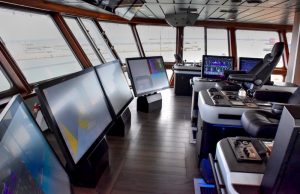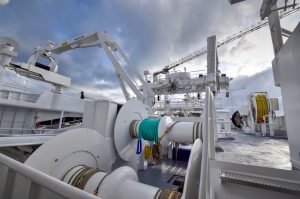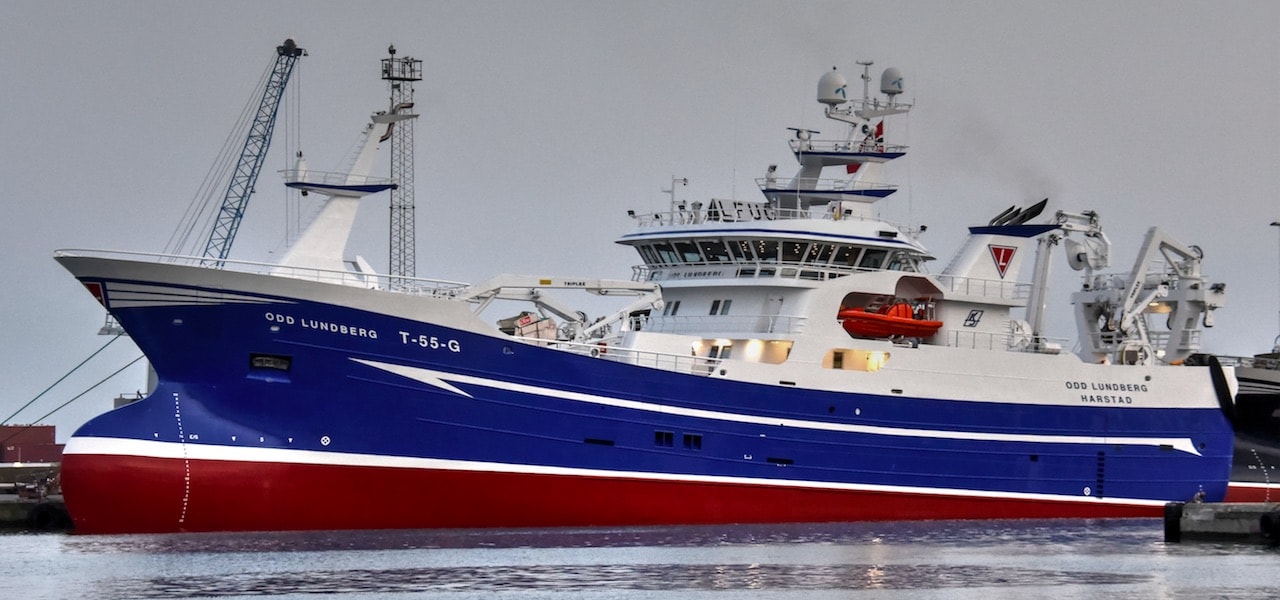It’s a fishing company that goes back more than a century. In 1918 Søren Lundberg bought a quarter share in 56-foot fishing boat Harpun and within a few years was running his own boats. The first to carry the Odd Lundberg name, named after one of his sons who had died while still a young man, was a 98-foot purse seiner built at Hardanger in 1956 – and the latest to carry the name has just been delivered by Karstensens Skibsværft in Skagen.
Owned by Norwegian company Odd Lundberg AS, the 69.99 metre LOA, 15.20 metre beam Odd Lundberg is built for to trawl primarily for sandeel and blue whiting, and to purse seine for herring and mackerel, with catches held in its 2185 cubic metre RSW tank capacity.

The contract for the new vessel was signed with Karstensens in June 2017, and it’s just over two years later that the new vessel is delivered and will be christened at its home port of Foldvik in Gratangen on 31st August.
The company is still run by the Lundberg family, with brothers Tore and general manager Geir Lundberg in charge, and Geir’s son Mats sailing as skipper and his brother Stian as chief engineer. Mats and Stian Lundberg have also been closely involved in the entire construction process, partly in Poland but primarily in Skagen, together with the yard’s staff.
‘The company came to us because Karstensens Shipyard offers a complete package that is both economically and technically very attractive,’ said the yard’s Kent Damgaard.
‘It was a vital factor for them to be involved throughout the design phase, so that it would be tailored exactly to their wishes and requirements. We welcome the confidence that the Lundberg family have shown in us. They have been a regular customer at the yard for many years, and therefore it’s pleasing that this constructive co-operation has been continued.‘
He added that like the other pelagic vessels the yard had already delivered and has on its orderbook, Odd Lundberg is a unique design.
‘This ensures that financial aspects are optimised, provides a short decision-making process and clear delimitation of responsibilities. These are benefits that other shipowners have also seen, and the yard is negotiating similar designs for potential Norwegian customers.’
The overall design, interior design and arrangement have been reached through a close collaborative process between the owner and the yard’s design team, and the Lundberg family brought a number of innovative suggestions to the design process. Particular attention has been paid to safe working conditions, with a fully watertight deck adding almost three metres to the freeboard.
Optimised
The hull design has been optimised to correspond to Odd Lundberg’s operating profile and to achieve maximum efficiency in fuel consumption, plus heat recovery systems are fitted to all of the engines, winches and electric fish pump, alongside a number of measures to ensure minimum energy consumption.

Odd Lundberg’s engine room is fitted with a MAN 6L32/44 CR common rail main engine driving a Brunvoll Volda ACG 980-2 two-step reduction gear and a 4200mm CP98/4 propeller. There is a Cummins AvK, 2500 kW shaft generator, plus one 992kWe Cummins QSK-38DM and two 567kWe QSK-19DM auxiliaries, with an ingenious arrangement that allows an output boost to the 3600kW main engine via the PTI when full power is needed for trawling
During fishing, when the electric winch system is used more or less continuously, the main gear’s PTO and the shaft generator will be switched on. When full power is needed for the winches, full performance on the main engine will not be needed.
With the main engine used solely for propulsion, the auxiliaries can supply sufficient power together to run the ship’s normal power supply, including load on the winch system.
As the electrical system is prepared for parallel coupling of the generators, this ensures a high level of security in the system, as these together can adequately cover the vessel’s power consumption. The main board is arranged so that the shaft generator can power the Brunvoll side thrusters, and the generators meet the requirements of the ship’s other electrical systems.
Electric deck equipment
Odd Lundberg’s owners opted for a fully electrical deck equipment system from MacGregor Rapp Marine, with 80-tonne trawl winches and a pair of 92.60 tonne net drums, as well the full set of additional winches for handling pelagic trawl gear. The vessel is laid out for pumping both over the starboard side when pursing and at the stern when trawling, with a pair of 24-inch electric fish pumps and the accompanying reels for the power cables and pumping hoses.

The 37.30-tonne purse winches are from Rapp Marine and Triplex supplied the purse seining hardware, including the Triplex 1020 electric hauler, in addition to the three KN-60 foredeck and fish pump cranes, the NK-7500 net winch crane and the corkline and leadline stackers.
The RSW system for the eleven tanks with a total 2185 cubic metre capacity is a double Johnson Controls system and C-Flow supplied the vacuum system with two 4200 litre tanks and four 66kW power packs.
The wheelhouse is fitted out with a top-of-the-range package that includes a Furuno mk2 Videowall facing the control positions.
The fishfinders are ST-93 low frequency, CS-90 medium frequency and SN-90 scanning sonars, as well as an ES-80 echo sounder and a pair of FS-70 headline sonars, all from Simrad. The 3D sonar is from WASSP. A Scanmar Scanbas 365 monitors the trawl sensors.
Plotters are MaxSea TimeZero and Olex sets. The current log is a JLN 652BB from JRC. The 2238BB and 2218BB radars and the SC-130 GPS compass are from Furuno. Simrad supplied the GC-80 gyro compass and the AP-80autopilot. There are two Tecdis T-2138A ECDIS installations and the thermal imaging camera is a gyro-stabilised Flir M625 unit.





